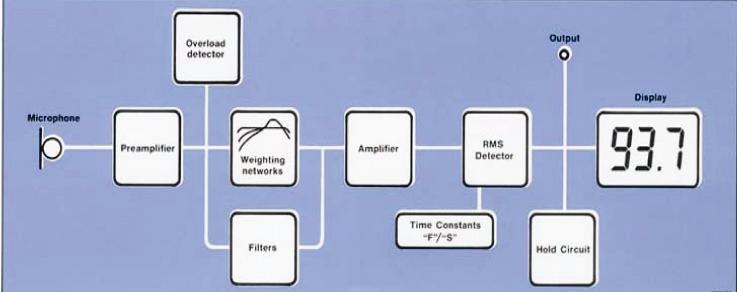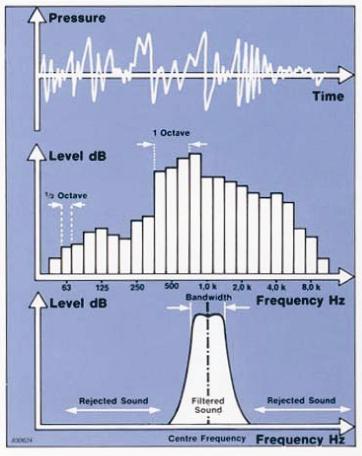A sound level meter is an instrument designed to respond to sound in approximately the same way as the human ear and to give objective, reproducible measurements of sound pressure level. There are many different sound measuring systems available. Although different in detail, each system consists of a microphone, an processing section and a read-out unit.
The microphone converts the sound signal to an equivalent electrical signal. The most suitable type of microphone for sound level meters is the condenser microphone, which combines precision with stability and reliability. The electrical signal produced by the microphone is quite small and so it is amplified by a preamplifier before being processed.
Several different types of processing may be performed on the signal. The signal may pass through a weighting network. It is relatively simple to build an electronic circuit whose sensitivity varies with frequency in the same way as the human ear, thus simulating the equal loudness contours. This has resulted in three different internationally standardized characteristics
termed the "A", "B" and "C" weightings.

|
The "A" weighting network weights a signal in a manner which approximates to an inverted equal loudness contour at low SPLs, the "B" network corresponds to a contour at medium SPLs and the "C" network to an equal loudness contour at high SPLs. A specialized characteristic, the "D" weighting, has also been standardized for aircraft noise measurements. |
 |
 |
When more detailed information about a complex sound is required, the frequency range from 20 Hz to 20 kHz can be divided up into sections or bands. This is done with electronic filters which reject all sound with frequencies outside the selected band. These bands usually have a bandwidth of either one octave or one third octave. An octave is a frequency band where the highest frequency is twice the lowest frequency. For example, an octave filter with a centre frequency of 1 kHz admits frequencies between 707 and 1414 Hz, but rejects all others. (The name octave stems from the fact that an octave covers eight notes of the diatonic musical scale). A third octave covers a range where the highest frequency is 1,26 times the lowest frequency. The process of thus dividing a complex sound is termed frequency analysis and the results are presented on a chart called a spectrogram. After the signal has been weighted and/or divided into frequency bands the resultant signal is amplified, and the Root Mean Square (RMS) value determined in an RMS detector. The RMS is a special kind of mathematical average value. It is of importance in sound measurements because the RMS value is directly related to the amount of energy in the sound being measured. The last stage of a sound level meter is the read-out unit which displays the sound level in dB, or some other derived unit such as dB(A) (which means that the measured sound level has been A-weighted). The signal may also be available at output sockets, in either AC or DC form, for connection to external instruments such as level or tape recorders to provide a record and/or for further processing. (from Bruel & Kjar) |


